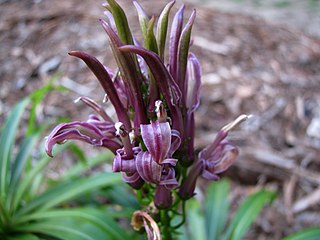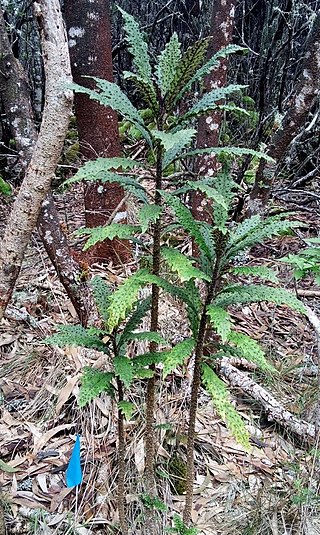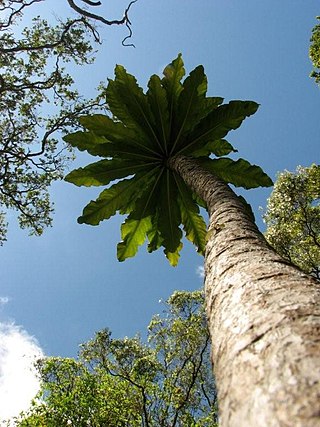
The Hawaiian tropical rainforests are a tropical moist broadleaf forest ecoregion in the Hawaiian Islands. They cover an area of 6,700 km2 (2,600 sq mi) in the windward lowlands and montane regions of the islands. Coastal mesic forests are found at elevations from sea level to 300 m (980 ft). Mixed mesic forests occur at elevations of 750 to 1,250 m, while wet forests are found from 1,250 to 1,700 m. Moist bogs and shrublands exist on montane plateaus and depressions. For the 28 million years of existence of the Hawaiian Islands, they have been isolated from the rest of the world by vast stretches of the Pacific Ocean, and this isolation has resulted in the evolution of an incredible diversity of endemic species, including fungi, mosses, snails, birds, and other wildlife. In the lush, moist forests high in the mountains, trees are draped with vines, orchids, ferns, and mosses. This ecoregion includes one of the world's wettest places, the slopes of Mount Waiʻaleʻale, which average 373 in (9,500 mm) of rainfall per year.

The Hawaiian lobelioids are a group of flowering plants in the bellflower family, Campanulaceae, subfamily Lobelioideae, all of which are endemic to the Hawaiian Islands. This is the largest plant radiation in the Hawaiian Islands, and indeed the largest on any island archipelago, with over 125 species. The six genera involved can be broadly separated based on growth habit: Clermontia are typically branched shrubs or small trees, up to 7 metres (23 ft) tall, with fleshy fruits; Cyanea and Delissea are typically unbranched or branching only at the base, with a cluster of relatively broad leaves at the apex and fleshy fruits; Lobelia and Trematolobelia have long thin leaves down a single, non-woody stem and capsular fruits with wind-dispersed seeds; and the peculiar Brighamia have a short, thick stem with a dense cluster of broad leaves, elongate white flowers, and capsular fruits. The relationships among the genera and sections remains unsettled as of April 2022.

Melicope knudsenii, commonly known as Olokele Valley melicope or Knudsen's melicope, is a species of flowering plant in the family Rutaceae, that is endemic to Hawaii. It inhabits montane mesic forests dominated by Acacia koa, Metrosideros polymorpha, and Dicranopteris linearis on Kauaʻi and East Maui (Auwahi). Associated plants include Syzygium sandwicensis, Cheirodendron trigynum, Myrsine lessertiana, Ilex anomala, Alphitonia ponderosa, Zanthoxylum dipetalum, Kadua terminalis, Pleomele aurea, Bobea spp., Tetraplasandra waimeae, Xylosma hawaiensis, Eurya sandwicensis, Psychotria mariniana, Melicope anisata, Melicope barbigera, Planchonella sandwicensis, Dodonaea viscosa, and Dianella sandwicensis. It is threatened by habitat loss. Like other Hawaiian Melicope, this species is known as alani. This is a federally listed endangered species of the United States.
Cyanea crispa is a rare species of flowering plant known by the common names crimped rollandia and Koolau Range rollandia. It is endemic to Oahu, where there are no more than fifty individuals remaining in the Koʻolau Range. It is a federally listed endangered species of the United States. Like other Cyanea it is known as haha in Hawaiian.
Cyanea acuminata is a rare species of flowering plant known by the common names Honolulu cyanea. It is endemic to Oahu, where there are no more than 250 individuals remaining. It is a federally listed endangered species of the United States. Like other Cyanea it is known as haha in Hawaiian.

Cyanea asarifolia is a rare species of flowering plant in the bellflower family known by the common name gingerleaf cyanea. It is endemic to Kauai, where there were no more than 30 individuals in a single population as of 2005. It is a federally listed endangered species of the United States. Like other Cyanea it is known as haha in Hawaiian.
Cyanea dolichopoda was a species of shrub in the bellflower family that was endemic to Kauai. It was discovered in 1990 and has not been located in the wild since 1992. Like other Cyanea it is known as haha in Hawaiian.
Cyanea dunbariae is a rare species of flowering plant in the bellflower family known by the common name ravine cyanea. It is endemic to Molokai, where there were sixteen plants remaining in the wild as of 2005. It is a federally listed endangered species of the United States. Like other Cyanea it is known as haha in Hawaiian.
Cyanea eleeleensis was a rare species of flowering plant in the bellflower family known by the common name Eleele cyanea. It was endemic to Kauai, where it has been declared extinct. It was federally listed as a critically endangered species of the United States in 2010. Like other Cyanea it is known as haha in Hawaiian.

Cyanea hamatiflora is a rare species of flowering plant in the bellflower family known by the common name wetforest cyanea. It is endemic to Hawaii, where it is known from the islands of Maui and Hawaii, and there are probably fewer than 250 plants remaining in total. It is a federally listed endangered species. Like other Cyanea it is known as haha in Hawaiian.

Cyanea lobata is a rare species of flowering plant in the bellflower family known by the common name Waihee Valley cyanea. It is endemic to Hawaii, where it is known from Lanai and Maui. It is a federally listed endangered species. Like other Cyanea it is known as haha in Hawaiian.
Cyanea longiflora is a rare species of flowering plant in the bellflower family known by the common name ridge rollandia. It is endemic to Oahu where there are only three remaining occurrences in the northern Waianae Mountains for a total of under 300 individuals. It is a federally listed endangered species. Like other Cyanea it is known as haha in Hawaiian.
Cyanea mceldowneyi is a rare species of flowering plant in the bellflower family known by the common name McEldowney cyanea. It is endemic to Hawaii, where it is known only from the island of Maui. A 2007 count estimated 60 plants remaining in two populations. It was federally listed as an endangered species of the United States in 1992. Like other Cyanea it is known as haha in Hawaiian.

Cyanea pinnatifida is a rare species of flowering plant in the bellflower family known by the common name sharktail cyanea. It is endemic to Oahu, but it is now extinct in the wild and only exists in cultivation. Like other Cyanea it is known as haha in Hawaiian.
Cyanea procera is a rare species of flowering plant in the bellflower family known by the common name Molokai cyanea. It is endemic to Hawaii, where it is known only from the island of Molokaʻi. It is a federally listed endangered species of the United States. Like other Cyanea it is known as haha in Hawaiian.

Cyanea remyi is a rare species of flowering plant in the bellflower family known by the common name Remy's cyanea. It is endemic to Hawaii, where it is known only from the island of Kauai. It is a federally listed endangered species of the United States. Like other Cyanea, it is known as haha in Hawaiian.
Cyanea st.-johnii is a rare species of flowering plant in the bellflower family known by the common name St. John's rollandia. It is endemic to Oahu, where it is known only from the Koʻolau Mountains. It is a federally listed endangered species of the United States. Like other Cyanea it is known as haha in Hawaiian.

Cyanea stictophylla is a rare species of flowering plant in the bellflower family known by the common name Kaiholena cyanea. It is endemic to the island of Hawaii, where it is known only from the rainforests of Mauna Loa. It is a federally listed endangered species of the United States. Like other Cyanea it is known as haha in Hawaiian.

Cyanea superba is a rare species of flowering plant in the bellflower family known by the common names Mt. Kaala cyanea and superb cyanea. It is endemic to the island of Oahu, but it is now extinct in the wild. It exists in cultivation and some individuals have been planted in appropriate habitat. It is a federally listed endangered species of the United States. Like other Cyanea it is known as haha in Hawaiian.

Cyanea truncata is a rare species of flowering plant in the bellflower family known by the common name Punaluu cyanea. It is endemic to the islands of Oahu and Molokai in Hawaii, but it is now critically endangered. It exists in cultivation and some individuals have been planted in appropriate habitat. It is a federally listed endangered species of the United States. Like other Cyanea it is known as haha in Hawaiian.











